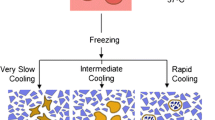Abstract
Successfully recovering stored cryopreserved cells requires attention to two major factors, i.e., storage temperature and proper handling of the frozen samples. These key considerations are in turn impacted by how the inventory system is constructed, the frequency and process for retrieving specimens, as well as how the material is secured. In addition, shipping biological materials requires attention to the type of material transported, adherence to regulatory requirements, packaging materials and proper assembly, labeling, and engaging reputable carriers. This paper provides an overview discussion of the current best practices for storing, handling, and shipping of cryopreserved cells and provides references to more detailed information on specific topics.
Similar content being viewed by others
References
Biosafety in Microbiological and Biomedical Laboratories (2009) 5th edition, U.S. Department of Health and Human Services, public health service, centers for disease control and NIH. Bethesda, Maryland
Mazur P (1984) Freezing of living cells: mechanisms and implications. Am J Phys 247:125–142
Ogden S (2007) Temperature, relative humidity, light, and air quality: basic guidelines for preservation. Northeast Document Conservation Center Preservation Leaflets 2.1. Available online at http://www.nedcc.org/resources/leaflets/2The_Environment/01BasicGuidelines.php (30 April 2015)
Peterman K, Simione F (2009) Preservation, storage and transport: integrity and compliance. In: Schaechter M (ed) encyclopedia of microbiology. Elsevier, Oxford, pp 261–270. https://doi.org/10.1016/B978-012373944-5.00111-5
Simione FP (1992) Key issues relating to the genetic stability and preservation of cells and cell banks. J Parent Sci Technol 46:226–232
Simione FP (1999) Cryopreservation: storage and documentation systems. In: Avis KE, Wagner CM, Wu VL (eds) Biotechnology: quality assurance and validation, drug manufacturing technology series, vol 4. Interpharm press, buffalo grove, Illinois, pp 7–31
Simione FP, Karpinsky JZ (1996) Points to consider before validating a liquid nitrogen freezer. In: Validation practices for biotechnology products, ASTM STP 1260 American Society for Testing and Materials, pp. 24–30
Stevenson R (1963) Collection, preservation, characterization and distribution of cell cultures. In: Proceedings: Symposium on the Characterization and Uses of Human Diploid Cell Strains. International Association of Microbiological Societies, Opatija, Yugoslavia, p 417
Tedder RS, Zuckerman MA, Goldstone AH, Hawkins AE, Fielding A, Briggs EM, Irwin D, Blair S, Gorman AM, Patterson KG (1995) Hepatitis B transmission from contaminated cryopreservation tank. Lancet 346(8968):137–140. https://doi.org/10.1016/S0140-6736(95)91207-X
Acknowledgements
The authors would like to thank the following for their invaluable contributions and review of the manuscript—John Baust, Gertrude Case Buehring, Lia Campbell, Eugene Elmore, John W. Harbell, Raymond W. Nims, Paul Price, Yvonne Reid, and Brian Shapiro.
Author information
Authors and Affiliations
Corresponding author
Additional information
Editor: Tetsuji Okamoto
Glossary
- CITES
-
Convention on International Trade in Endangered Species of Wild Fauna and Flora is an international agreement between governments. Its aim is to ensure that international trade in specimens of wild animals and plants does not threaten their survival.
- Cryogenic temperatures
-
Temperatures at or below − 150°C
- Cryopreservative
-
A chemical additive used to protect living cells during freezing
- Dangerous goods
-
Materials that present health and environmental hazards
- DOT
-
Department of Transportation; US Federal Agency responsible for planning and coordinating federal transportation projects. It also sets safety regulations for all major modes of transportation.
- Dry ice
-
Solid carbon dioxide
- IATA
-
International Air Transport Association, the agency that supports aviation with global standards for airline safety, security, efficiency, and sustainability.
- ICAO
-
International Civil Aviation Organizations, a non-government organization (NGO) body under the UN that coordinates many issues including the transportation by air of dangerous goods.
- Liquid nitrogen
-
Liquefied nitrogen gas.
- Temperature gradient
-
The range in temperature from the coldest area of a freezer to the warmest area
- Thermal risk
-
Exposure of frozen specimens to temperatures greater than the storage temperature
- Validation
-
The action of checking or proving the effectiveness or accuracy of something
Rights and permissions
About this article
Cite this article
Simione, F., Sharp, T. Best practices for storing and shipping cryopreserved cells. In Vitro Cell.Dev.Biol.-Animal 53, 888–895 (2017). https://doi.org/10.1007/s11626-017-0214-6
Received:
Accepted:
Published:
Issue Date:
DOI: https://doi.org/10.1007/s11626-017-0214-6




